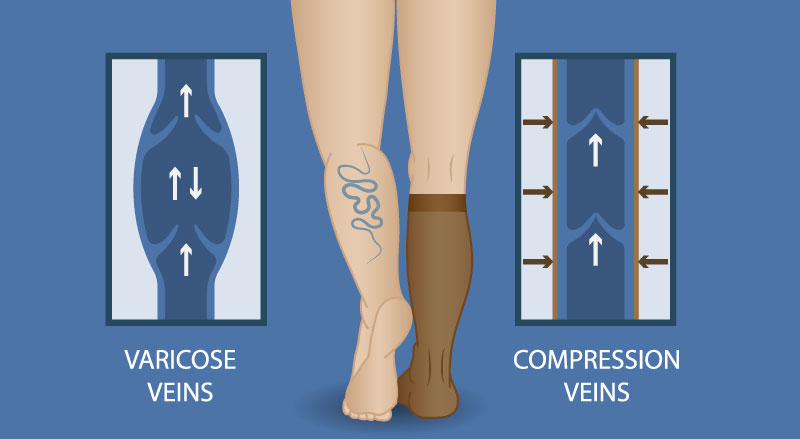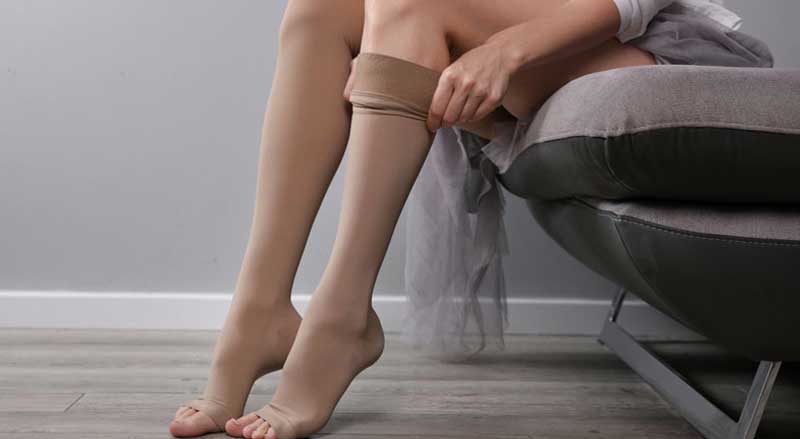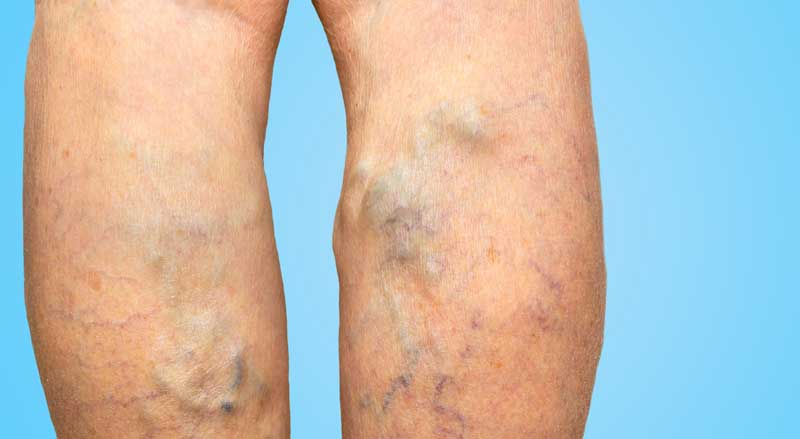Varicose veins are those unsightly bulging veins that you often see on legs or feet. If you have them, you’re probably aware of the discomfort or pain they can cause—especially after a long day of standing or sitting.
Compression therapy helps reduce the inflammation and pain caused by varicose veins—it also improves poor blood circulation.
Is compression therapy always the best way to treat varicose veins? And how does compression therapy for varicose veins work?
Here are the answers.
What Are Varicose Veins?
People usually find varicose veins—those enlarged and twisted veins—on their calves, ankles, and/or thighs. But they can be almost anywhere on your body. The veins are dark purple or blue and aren’t often a medical concern.
However, for many people, varicose veins are a cosmetic concern; they cause embarrassment when you’re wearing shorts, a skirt, or a bathing suit.
Other times, varicose veins can reveal a budding health issue or even pose a health risk themselves.
Varicose veins are caused by valve problems within the veins. Valves become damaged or weak and blood circulation is affected; the blood begins to pool in the legs and veins enlarge.

Some symptoms associated with varicose veins include:
- Swelling in the ankles or legs
- A feeling of heaviness in your legs
- Itching around the vein area
- Achiness or pain in your legs
- Skin discoloration around the veins
At times, untreated varicose veins lead to other health issues, including venous ulcerations or chronic venous insufficiency (CVI).
The weakening of vein walls from chronic vein valve problems is a common cause of CVI. Blood flow toward the heart decreases and instead blood pools in the legs. CVI itself is not life-threatening but can lead to serious health complications including deep vein thrombosis, pulmonary embolism, and leg ulcers.
Read about warning signs and diagnosing varicose vein disease.
Causes of Varicose Veins
Factors that contribute to the development of varicose veins include:
- A sedentary lifestyle
- Being overweight
- Pregnancy
- Aging
- Increased blood pressure in the veins
What is Compression Therapy?
Many vein doctors consider compression therapy to be the first line of treatment for mild-to-moderate varicose veins. They often suggest combining compression therapy with leg elevation or movement exercises.
Compression therapy helps eliminate many of the physical symptoms associated with varicose veins. It can also help with leg or foot discomfort associated with:
- Chronic venous insufficiency
- Deep vein thrombosis (DVT)
- Swelling of the legs, ankles, and feet
- Pregnancy

Compression treatment is non-invasive; it simply involves wearing compression (elastic) socks, stockings, or wraps. By applying continuous pressure to your legs and squeezing leg muscles, the compression clothing helps push blood upward against gravity, making it easier for blood to flow back to your heart.
This treatment also keeps fluid from building up in the legs, feet, and ankles, prevents blood clots, and helps ulcers heal on the skin.
Your legs will feel:
- More comfortable
- Less painful
- Less tired
- Less swollen
- Better supported
Wearing the proper compression stockings will also help keep veins from getting worse.
A vein specialist can evaluate your vein health and recommend the exact type and amount of compression that will work best for you. You can purchase some compression stockings over the counter, while others require a prescription.
Compression stockings are also often recommended both before and after vein treatment.
Learn more about the symptoms and causes of poor circulation in the legs and feet.
Types of Compression Therapy

Compression socks
Compression socks may extend to different lengths, from just over the ankle to up to your knee.
If you’re standing or sitting for extended periods during the day, ankle compression socks can keep your feet feeling comfortable.
Manufacturers rate socks to show the pressure they provide.
Units of measurement are listed as “mmHg,” which stands for millimeters of mercury—a measurement of pressure. Compression sock ratings include:
- Low—less than 20 mmHg—do not require a prescription
- Medium—20-30 mmHg—require a prescription
- High—More than 30 mmHg—require a prescription
If you have moderate-to-severe varicose veins, your doctor will probably write you a prescription for compression socks for pain relief and improved circulation.
Compression Stockings

Compression socks are a common type of compression wear. They reach up to the knee. Longer compression stockings (sleeves or tights) are available if swelling goes higher than your knee.
Compression stockings can be rated or not rated for pressure. The socks and stockings should feel comfortably snug but shouldn’t feel overly tight or painful.
Velcro Wraps and Bandages
These compression items are helpful for people who have trouble putting on socks. The elastic bandages often require several layers while wraps can have convenient Velcro closures.
Inflatable garments is another category of compression-wear. Users inflate these devices to a specific amount of pressure. They’re generally used by athletes to reduce muscle soreness and improve blood circulation to speed recovery.
Other Treatments for Varicose Veins
While compression garments usually help reduce discomfort caused by varicose veins, they cannot fix varicose veins or improve their physical appearance.
However, today there are many varicose vein treatments that will permanently eliminate existing varicose and spider veins.
Treatments for the elimination of varicose veins include:
Is Compression Therapy for You?
There are some medical conditions that make it unsafe to use compression therapy. One of these conditions is peripheral artery disease (PAD). Here, compression therapy would be harmful since the blood vessels in the legs would narrow and reduce blood flow.
It’s always recommended that you consult your doctor first before you start compression therapy.
Here’s more about vein conditions and ways to improve your vein health.
For a free varicose vein screening, contact us at The New Jersey Vein and Vascular Center.


